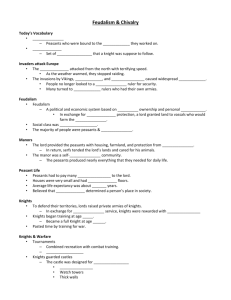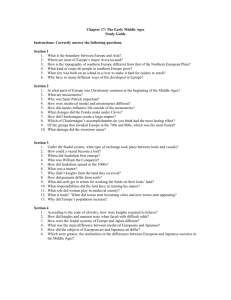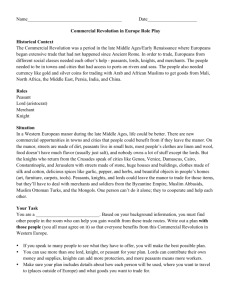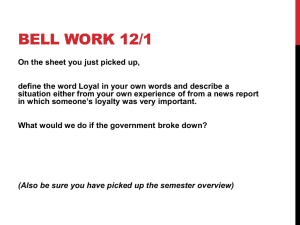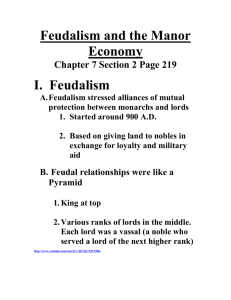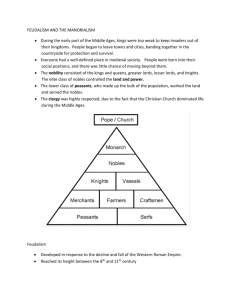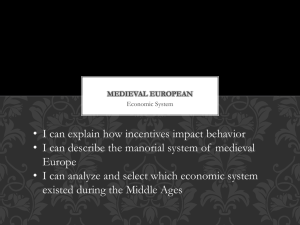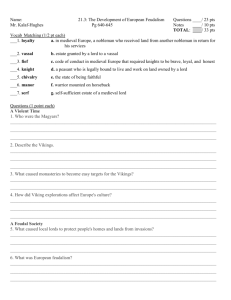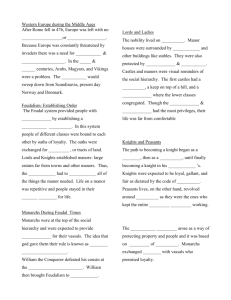Feudalism and the Manor Economy
advertisement
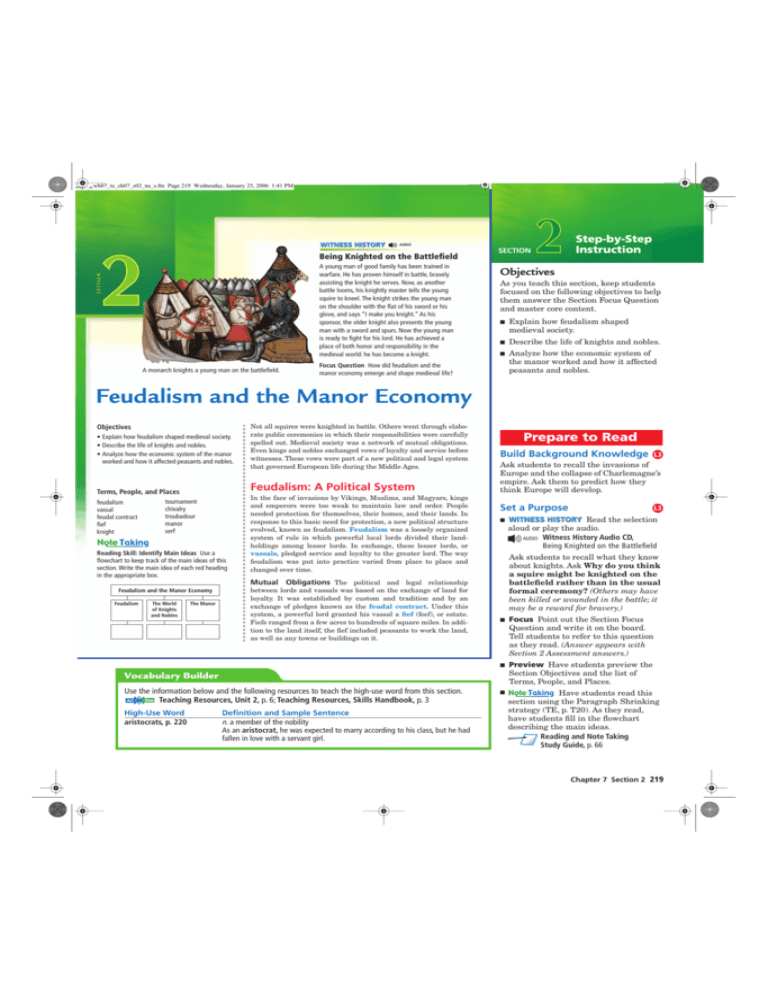
wh07_te_ch07_s02_na_s.fm 219 15, Wednesday, January wh07_se_ch07_s02_s.fm Page 219 Thursday,Page December 2005 6:39 PM 25, 2006 1:41 PM 2 WITNESS HISTORY AUDIO Being Knighted on the Battlefield A young man of good family has been trained in warfare. He has proven himself in battle, bravely assisting the knight he serves. Now, as another battle looms, his knightly master tells the young squire to kneel. The knight strikes the young man on the shoulder with the flat of his sword or his glove, and says “I make you knight.” As his sponsor, the older knight also presents the young man with a sword and spurs. Now the young man is ready to fight for his lord. He has achieved a place of both honor and responsibility in the medieval world: he has become a knight. A monarch knights a young man on the battlefield. SECTION 2 Step-by-Step Instruction Objectives As you teach this section, keep students focused on the following objectives to help them answer the Section Focus Question and master core content. ■ Explain how feudalism shaped medieval society. ■ Describe the life of knights and nobles. ■ Analyze how the economic system of the manor worked and how it affected peasants and nobles. Focus Question How did feudalism and the manor economy emerge and shape medieval life? Feudalism and the Manor Economy Objectives • Explain how feudalism shaped medieval society. • Describe the life of knights and nobles. • Analyze how the economic system of the manor worked and how it affected peasants and nobles. Feudalism: A Political System Terms, People, and Places feudalism vassal feudal contract fief knight tournament chivalry troubadour manor serf Reading Skill: Identify Main Ideas Use a flowchart to keep track of the main ideas of this section. Write the main idea of each red heading in the appropriate box. Feudalism and the Manor Economy Feudalism The World of Knights and Nobles Not all squires were knighted in battle. Others went through elaborate public ceremonies in which their responsibilities were carefully spelled out. Medieval society was a network of mutual obligations. Even kings and nobles exchanged vows of loyalty and service before witnesses. These vows were part of a new political and legal system that governed European life during the Middle Ages. The Manor In the face of invasions by Vikings, Muslims, and Magyars, kings and emperors were too weak to maintain law and order. People needed protection for themselves, their homes, and their lands. In response to this basic need for protection, a new political structure evolved, known as feudalism. Feudalism was a loosely organized system of rule in which powerful local lords divided their landholdings among lesser lords. In exchange, these lesser lords, or vassals, pledged service and loyalty to the greater lord. The way feudalism was put into practice varied from place to place and changed over time. Mutual Obligations The political and legal relationship between lords and vassals was based on the exchange of land for loyalty. It was established by custom and tradition and by an exchange of pledges known as the feudal contract. Under this system, a powerful lord granted his vassal a fief (feef), or estate. Fiefs ranged from a few acres to hundreds of square miles. In addition to the land itself, the fief included peasants to work the land, as well as any towns or buildings on it. Prepare to Read Build Background Knowledge Ask students to recall the invasions of Europe and the collapse of Charlemagne’s empire. Ask them to predict how they think Europe will develop. Set a Purpose ■ High-Use Word aristocrats, p. 220 Definition and Sample Sentence n. a member of the nobility As an aristocrat, he was expected to marry according to his class, but he had fallen in love with a servant girl. L3 WITNESS HISTORY Read the selection aloud or play the audio. AUDIO Witness History Audio CD, Being Knighted on the Battlefield Ask students to recall what they know about knights. Ask Why do you think a squire might be knighted on the battlefield rather than in the usual formal ceremony? (Others may have been killed or wounded in the battle; it may be a reward for bravery.) ■ Focus Point out the Section Focus Question and write it on the board. Tell students to refer to this question as they read. (Answer appears with Section 2 Assessment answers.) ■ Preview Have students preview the Section Objectives and the list of Terms, People, and Places. ■ Have students read this section using the Paragraph Shrinking strategy (TE, p. T20). As they read, have students fill in the flowchart describing the main ideas. Reading and Note Taking Study Guide, p. 66 Vocabulary Builder Use the information below and the following resources to teach the high-use word from this section. Teaching Resources, Unit 2, p. 6; Teaching Resources, Skills Handbook, p. 3 L3 Chapter 7 Section 2 219 wh07_te_ch07_s02_na_s.fm Page 220 Wednesday, November 2, 2005 11:40 AM wh07_se_ch07_s02_s.fm Page 220 Monday, September 26, 2005 2:18 PM As part of this agreement, the lord promised to protect his vassal. In return, the vassal pledged loyalty to his lord. He also agreed to provide the lord with 40 days of military service each year, certain money payments, and advice. Teach Feudalism L3 Instruct n Introduce: Vocabulary Builder Vocabulary Builder aristocrats—(uh RIS tuh krats) n. members of the nobility Have students read the Vocabulary Builder term and definition. Tell students that aristocrats were a powerful social class in medieval Europe. n Teach Ask What obligations did a vassal have to his lord? (loyalty, military service, money, advice) What obligations did a lord have to his vassals? (fief, protection) Brainstorm scenarios in which a vassal’s conflicting loyalties could be a problem. Then explain the concept of liege lord, to whom a vassel owed his first loyalty, and discuss how it solved this problem. A Structured Society All aristocrats had a place in this structure of power. Below the monarch were powerful lords, such as dukes and counts, who held the largest fiefs. Each of these lords had vassals, and these vassals in turn had their own vassals. In many cases, the same man was both vassal and lord—vassal to a more powerful lord above him and lord to a less powerful vassal below him. Because vassals often held fiefs from more than one lord, relationships between them grew very complex. A vassal who had pledged loyalty to several lords could have serious problems if his overlords quarreled with each other. What was he to do if both demanded his aid? To solve this problem, a vassal usually had a liege lord to whom he owed his first loyalty. What was the relationship between lords and vassals? The World of Knights and Nobles For medieval nobles, warfare was a way of life. Rival lords battled constantly for power. Many nobles began training in boyhood for a future occupation as a knight, or mounted warrior. n Quick Activity Show students The Rise of Feudalism from the Witness History Discovery School™ video program. Ask students to explain how feudalism provided stability in an uncertain time. (Answers should refer to the uncertainty caused by the competing lords and the invading bandits and the ways in which the vassal-lord relationship provided protection.) Independent Practice Primary Source To help students understand feudal obligations, have them read Feudal Obligations and complete the worksheet. Then have groups of students create a diagram of the structure of feudal society. Teaching Resources, Unit 2, p. 8 Monitor Progress As groups create their diagrams, circulate to ensure they understand the mutual obligations inherent in the structure of feudal society. For a completed version of the diagram, see the Quick Study Guide at the end of this chapter. INFOGRAPHIC C astles were made for defense. They were large complexes where many people and their supplies could hold out for long periods. They had strong, thick stone walls. A drawbridge over the castle moat—a ditch filled with water—could be raised in case of attack. One way to capture a castle was by siege: the enemy would surround the castle and wait until the defenders’ food ran out and they had to surrender. But soldiers could also attack by going over, through, or under the castle’s defenses. Some attackers filled in the moat with stones or tunneled under the walls to weaken them until they collapsed. More often, they shot flaming arrows or hurled large stones over the walls. Some tried to go over the walls or to break down the gates. Motte and Bailey Castle This early type of castle was developed in the 800s. A keep, or tower, was built on a hill called a motte. A wooden bridge connected the motte to the bailey, a courtyard surrounded by a fence. Battering Ram Inside this hut on wheels was a huge log which soldiers used to break down the thick castle gate. Catapult A type of catapult called a trebuchet (TREB yoo shet) could hurl stones weighing 600 pounds (270 kilograms) as far as 1,000 feet (300 meters). Solutions for All Learners L1 Special Needs Answer They had mutual obligations: lords provided land and protection; vassals provided loyalty, military service, money, and advice. 220 The Rise of Europe L2 Less Proficient Readers After students have read the section, write the terms king, lord, knight, and peasant on the board. Under each term, write “Responsibilities” and “Privileges”. Ask students to share examples of responsibilities and privileges of each level of European feudal society. Write the examples on the board and ask students to copy them into their notebooks. L2 English Language Learners Use the following resources to help students acquire basic skills. Adapted Reading and Note Taking Study Guide n Adapted Note Taking Study Guide, p. 66 n Adapted Section Summary, p. 67 wh07_te_ch07_s02_na_s.fm Page 221 Wednesday, wh07_se_ch07_s02_s.fm Page 221 Monday, September 26, 2005 November 2:18 PM 2, 2005 11:40 AM Knights and Warfare At the age of seven, a boy slated to become a knight was sent away to the castle of his father’s lord. There, he learned to ride and fight. He also learned to keep his armor and weapons in good condition. Training was difficult and discipline was strict. Any laziness was punished with an angry blow or even a severe beating. With his training finished, the youth was “dubbed” a knight, often in a public ceremony. His knight master or lord said words like these: “In the name of God, Saint Michael, and Saint George, I dub thee knight; be brave and loyal.” Then the young knight took his place beside other warriors. Knights usually fought on horseback using swords, axes, and lances, which were long poles. They wore armor and carried shields for protection. Other soldiers fought on foot using daggers, spears, crossbows, and longbows. In addition to actual warfare, knights engaged in mock battles called tournaments. WITNESS HISTORY VIDEO Watch The Rise of Feudalism on the Witness History Discovery School™ video program to learn about how the feudal system evolved in medieval Europe. L3 Instruct n Introduce Display Color Transparency 41: A Knight’s Armor and Weapons. Ask students to describe the knight’s armor and weaponry. Then have them turn to the chapter opener and compare this armor to that on the knights in tournament. Ask students to speculate what this armor suggests about knights and medieval society. Color Transparencies, 41 Castles and Defense During the early Middle Ages, powerful lords fortified their homes to withstand attack. The strongholds gradually became larger and grander. By the 1100s, monarchs and nobles owned sprawling stone castles with high walls, towers, and drawbridges over wide moats. They were not merely homes for the lords; they were also fortresses. The knights who defended the castle also lived there. In time of war, the peasants in the nearby villages would take refuge within the castle walls. Wars often centered on seizing castles that commanded strategic river crossings, harbors, or mountain passes. n Teach Point out that knights were the For: An interactive activity Web Code: nap-0721 Hooks and Ladders The castle’s defenders used poles with hooks to push away attackers’ ladders. They also showered the enemy with hot oil and flaming arrows. Siege Tower If attackers could span the moat, they would roll this huge tower up to the castle walls. Then they faced hand-to-hand combat at the top. The World of Knights and Nobles military forces of the Middle Ages. Ask Why were castles also important to medieval warfare? (They were a good defense against knights and the weapons of the time, and could protect many people.) How did noblewomen contribute to this warrior society? (They took over their husband’s lordly duties if they were away; brought inherited lands to their marriages; ran the daily life of the manor or castle). Then ask students to read the biography feature on Eleanor of Aquitaine. Ask What parts of Eleanor’s life do you find surprising? (Answers will vary.) Then ask What does this tell you about medieval society? (Like today, women’s positions could vary depending on their social status.) Ask How do you think her opportunities would have been different if she had been a peasant? (She would have had very little power, even over herself. She may not have been able to remarry.) n Analyzing the Visuals Ask volunThinking Critically 1. Express Problems Clearly What were some of the drawbacks of using a castle for defense? 2. Draw Inferences What technologies developed in response to castle defenses? teers to read aloud the various defenses of a castle. Ask Which facts are the most impressive or most startling? (Answers should show an appreciation of the resources and inventiveness both attackers and defenders used.) What do the many layers of defenses suggest about medieval society? (Warfare was common.) Link to Literature Chivalry in Camelot Most of our modern ideas about chivalry and courtly love come from the stories of King Arthur and the Knights of the Round Table. These stories had their beginnings in Celtic mythology dating to before the eleventh century. Later, a French poet named Chrétien de Troyes wrote a series of romances that named Arthur as their hero and added Arthur’s knights and the quest for the Holy Grail—the chalice used by Jesus at the Last Supper. In all of its various forms, the story tells of an illegitimate son of a king who wins his rightful place by drawing a sword from a stone. The new king is a worthy and courageous leader, and he inspires the allegiance of such heroic knights as Sir Lancelot. The illicit love between Lancelot and Arthur’s queen Guinevere forms another facet of the legend. Answers Thinking Critically 1. Sample: People could run out of food and gunpowder during a long siege, and many warriors were still needed inside to defend all the walls. 2. Sample: weapons such as those pictured and flaming arrows Chapter 7 Section 2 221 wh07_te_ch07_s02_na_s.fm Page 222 Wednesday, November 2, 2005 11:40 AM wh07_se_ch07_s02_s.fm Independent Practice n Web Code nap-0721 will take stu- dents to the interactive diagram of a castle under attack. Have students complete the interactivity and then answer the questions in the text. n Link to Literature To help students better understand chivalry, have them read the selection from Sir Thomas Malory’s Le Morte d’Arthur and complete the worksheet. Then discuss whether or not chivalry influenced knights’ behavior. Teaching Resources, Unit 2, p. 9 Monitor Progress To ensure student understanding, ask them to describe the defense system of medieval society. Page 222 Thursday, September 29, 2005 4:07 PM BIOGRAPHY Eleanor of Aquitaine Eleanor (1122–1204), daughter of the Duke of Aquitaine, inherited her father’s lands when he died in 1137. When she was only 15, she married the heir to the French throne. Eleanor had considerable influence over her husband, King Louis VII, and even accompanied him on the Second Crusade, wearing armor and riding on horseback alongside male crusaders. When Louis ended his marriage to Eleanor, she regained control of Aquitaine. In 1152, she married another king, Henry II of England, and again became active in politics. In 1173, Eleanor aided several of her sons in an attempt to overthrow Henry. When the revolt failed, Henry had Eleanor imprisoned. After Henry died, her son Richard (known as “the Lion-Heart”) became king of England. Richard freed his mother, and she later ruled in his place while he went on a crusade to the Holy Land. How did Eleanor expand the usual role of ENGLAND medieval women? At l a n t i c O cean FRANCE Aquitaine Noblewomen: Restrictions and Power Noblewomen played active roles in this warrior society. While her husband or father was off fighting, the “lady of the manor” took over his duties. She supervised vassals, managed the household, and performed necessary agricultural and medical tasks. Sometimes she might even have to go to war to defend her estate. A few medieval noblewomen took a hand in politics. For example, Eleanor of Aquitaine was a leading force in European politics for more than 50 years. Women’s rights to inheritance were restricted under the feudal system, although women did sometimes inherit fiefs. Land usually passed to the eldest son in a family. A woman frequently received land as part of her dowry, and fierce marriage negotiations swirled around an unmarried or widowed heiress. A widow retained her land. Like their brothers, the daughters of nobles were sent to friends or relatives for training. Before her parents arranged her marriage, a young woman was expected to know how to spin and weave and how to supervise servants. A few learned to read and write. In her role as wife, a noblewoman was expected to bear many children and be dutiful to her husband. Chivalry: Romance and Reality In the later Middle Ages, knights adopted a code of conduct called chivalry. Chivalry required knights to be brave, loyal, and true to their word. In warfare, they had to fight fairly. For example, a knight agreed not to attack another knight before the opponent had a chance to put on his armor. Warriors also had to treat a captured knight well or even release him if he promised to pay his ransom. Chivalry had limits, though. Its elaborate rules applied to nobles only, not to commoners. But chivalry also dictated that knights protect the weak, and that included both peasants and noblewomen. In theory, if not always in practice, chivalry placed women on a pedestal. Troubadours, or wandering musicians, sang about the brave deeds of knights and their devotion to their lady loves. Their songs became the basis for epic stories and poems. Few real knights could live up to the ideals of chivalry, but they did provide a standard against which a knight’s behavior could be measured. How was warfare central to life in the Middle Ages? The Manor: An Economic System The heart of the medieval economy was the manor, or lord’s estate. Most manors included one or more villages and the surrounding lands. Peasants, who made up the majority of the population in medieval society, lived and worked on the manor. Most peasants on a manor were serfs, bound to the land. Serfs were not slaves who could be bought and sold. Still, they were not free. They could not leave the manor without the lord’s permission. If the manor was granted to a new lord, the serfs went along with it. Answers BIOGRAPHY She was politically active, went on a crusade, and ruled England for her son. Rival lords battled constantly for power and also fought invaders. This gave rise to a class of warriors called knights and to the development of the castle, used as fortress for protection during warfare. 222 The Rise of Europe Solutions for All Learners L2 English Language Learners L4 Gifted and Talented Tell students to look at Defending a Castle. Ask them how the weapons shown in the illustration would have been used to breach a castle’s defenses. Follow up by asking how castles might have been designed to prevent these weapons from being used effectively. Have students use the image in the text and outside research to develop an attack plan for an invading army to take control of a fortified castle. Then ask them to create a defense plan that would enable a castle’s occupants to successfully withstand an invasion. wh07_te_ch07_s02_na_s.fm Page 223 Wednesday, wh07_se_ch07_s02_s.fm Page 223 Monday, September 26, 2005 November 6:29 PM 2, 2005 11:40 AM Lords and Peasants: Mutual Obligations Peasants and their lords were tied together by mutual rights and obligations. Peasants had to work several days a week farming the lord’s lands. They also repaired his roads, bridges, and fences. Peasants had to ask the lord’s permission to marry. Peasants paid the lord a fee when they inherited their father’s acres or when they used the local mill to grind grain. Other payments fell due at Christmas and Easter. Peasants had little opportunity to use money, so they paid with products such as grain, honey, eggs, or chickens. In return for their labor and other payments, peasants had the right to farm some land for themselves. They were also entitled to their lord’s protection from raids or warfare. Although they could not leave the manor freely, they also could not be forced off it. In theory, at least, they were guaranteed food, housing, and land. This system supported the nobility, making feudalism possible. A Self-Sufficient World The manor was generally self-sufficient. That is, the peasants who lived there produced almost everything they needed, from food and clothing to simple furniture and tools. Most peasants never ventured more than a few miles from their village. They had no schooling and no knowledge of a larger world outside. A typical manor included cottages and huts clustered close together in a village. Nearby stood a water mill to grind grain, a church, and the lord’s manor house. The fields surrounding the village were divided into narrow strips. Each family had strips of land in different fields so that good land and bad land were shared evenly. Long strips were also easier to plow. Beyond the fields for growing crops, there were pastures for animals and meadows that provided hay. The forests that lay beyond the cleared land—and all the animals in them—were usually reserved for the use of the lord. Life on the Manor The Manor: An Economic System L3 Instruct n Introduce: Key Terms Ask students to find the key term serfs (in blue) in the text and define its meaning. Discuss with students the difference between serfs and slaves. Some students may be familiar with the situation of sharecroppers. Ask students to speculate why serfdom was a central element to the manor system, the basic economic system of the Middle Ages. Check that they understand it ensured a lord a stable—and cheap—workforce. n Teach Point out that lords had obliga- tions not only to their vassals and their own lords, but also to their serfs and other peasants. Ask What did peasants do for lords? (worked their fields, repaired infrastructure, paid fees in the form of products) What did lords do for peasants? (gave them land to farm and protection) Use the Think-WritePair-Share strategy (TE, p. T23) and have students describe peasant life. Ask Why do you think peasants died so young? (hard work, poor diet, poor sanitation, disease) n Analyzing the Visuals Have students The lord of the manor and his family lived in relative luxury. As the illustration below shows, nobles had a variety of foods and were waited on by servants when they dined. Notice the lord’s home, or demesne, in the medieval diagram at the right and compare it with the village homes of the peasants who worked his land. look carefully at the images of noble life (this page) and peasant life (next page). Ask them to compare and contrast the images and the lifestyles they represent. Then have them use the diagram of the manor to identify where the lord’s family and the peasant’s family would spend their time. Independent Practice Viewpoints To help students better understand the differences between noble and peasant life, have them read the selection Two Views of Medieval Life and complete the worksheet. Teaching Resources, Unit 2, p. 10 Monitor Progress History Background The Manor Court The self-sufficiency of the manor extended beyond economic matters to the legal realm. The manor court was usually held in the lord’s hall, although the parish church might be used. In some cases, the oldest tree in the village was designated as the official court site. The court had jurisdiction over minor criminal, manorial, and civil matters—serious offenses were referred to the king or a higher lord. Criminal matters included stealing wood from the lord’s forest, selling underweight bread, poor plowing, or assault. Civil and manorial matters included the choosing of village officials and the recording of changes in land holding, inheritances, and dowries. The manor court was composed mostly of serfs and so afforded some protection against the arbitrary caprice of the lord; those peasants who spoke up often saw justice served. Reread the first sentence in this section: The heart of the medieval economy was the manor, or lord’s estate. To check student understanding, ask them to explain what is meant by this sentence. Chapter 7 Section 2 223 wh07_te_ch07_s02_na_s.fm Page 224 Tuesday, January 17, 2006 2:25 PM wh07_se_ch07_s02_s.fm Page 224 Thursday, September 29, 2005 4:08 PM Assess and Reteach Assess Progress ■ Have students complete the Section Assessment. ■ Administer the Section Quiz. L3 Teaching Resources, Unit 2, p. 3 ■ To further assess student understanding, use Progress Monitoring Transparencies, 28 Reteach If students need more instruction, have them read the section summary. Reading and Note Taking L3 Study Guide, p. 67 Adapted Reading and L1 L2 Note Taking Study Guide, p. 67 Spanish Reading and Note Taking Study Guide, p. 67 Extend L2 L4 Conduct the Unit 2 Simulation, Medieval Manor, which helps students understand the conflicting loyalties and aspects of daily life on a manor. Back-Breaking Labor These peasants use sickles to harvest grain under the watchful eye—and cane—of the lord’s official. A medieval sickle is shown above (right) along with a billhook for maintaining hedges. What does the illustration suggest about peasant life? Teaching Resources, Unit 2, pp. 122–125 Answers Lords granted land to peasants in return for their labor and certain fees. Lords also provided protection to peasants. Peasant labor on farms and as artisans made the manor self-sufficient. Caption life was difficult, filled with hard work; peasants were at the mercy of the lord’s officials 1. Sentences should reflect an understanding of each term, person, or place listed at the beginning of the section. 2. Feudalism emerged to provide protection against invaders and local power struggles. Lords exchanged land for loyalty and military service. Land was often organized into manors. The hierarchy of lord, lesser lord, knight, and peasant or serf 224 The Rise of Europe How did the manor system work? 2 Terms, People, and Places 1. For each term, person, or place listed at the beginning of the section, write a sentence explaining its significance. 2. Reading Skill: Identify Main Ideas Use your completed flowchart to answer the Focus Question: How did feudalism and the manor economy emerge and shape medieval life? Section 2 Assessment Peasant Life For most peasants, life was harsh. Men, women, and children worked long hours, from sunup to sundown. During planting season, a man might guide an ox-drawn plow through the fields while his wife walked alongside, urging the ox on with a pointed stick. Children helped in the fields, planting seeds, weeding, and taking care of pigs or sheep. In late winter, when the harvest was gone and new crops had not yet ripened, hunger was common. Disease took a heavy toll, and few peasants lived beyond the age of 35. The peasant family ate a simple diet of black bread with vegetables such as cabbage, turnips, or onions. They seldom had meat—that was reserved for the lord. Peasants who poached, or illegally killed wild game on their lord’s manor, risked harsh punishment. If they lived near a river, peasants might add fish to their diet. At night, the family and their livestock—cows, chickens, pigs, or sheep—slept together in their hut. Still, peasants found occasions to celebrate, such as marriages and births. Welcome breaks came at Christmas and Easter, when peasants had a week off from work. At these times, people might butcher an animal for a feast. There would also be dancing and rough sports, from wrestling to ball games. Progress Monitoring Online For: Self-quiz with vocabulary practice Web Code: naa-0721 Comprehension and Critical Thinking 3. Analyze Information How did a lord benefit from giving his lands away as fiefs? 4. Make Comparisons Compare the rights and obligations of noblemen and noblewomen during the Middle Ages. 5. Draw Conclusions How did the manor serve the needs of the early Middle Ages? stifled trade and the upward mobility of the majority of people. 3. He gained military support and loyalty. 4. Noblemen owed military service and loyalty to their lord. They guided and protected their vassals. Noblewomen owed loyalty and obedience to their husbands, but performed some of the lord’s duties if he was absent. They provided day-to-day management of the household and were expected to bear children. ● Writing About History Quick Write: Develop a Thesis and Choose Supporting Information Choose a group discussed in this section. Write a sentence expressing your view of this group’s place in medieval society. Jot down some information to support your statement. Revise this working thesis as you learn more. For example, you might begin with this thesis: Peasants did most of the work but derived few benefits from the manor system. 5. It provided safety and security for peasants and wealth and prestige for their lords. Since manors were self-sufficient, it did not matter that trade was limited. ● Writing About History Responses should show an understanding of how to develop a working thesis. For additional assessment, have students access Progress Monitoring Online at Web Code naa-0721.
